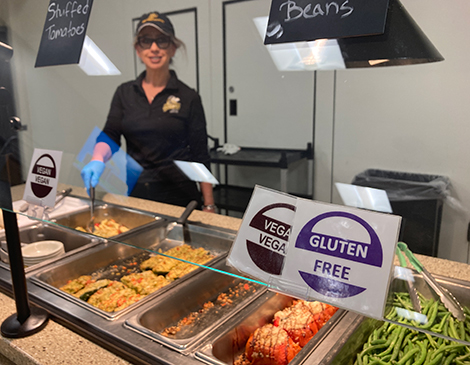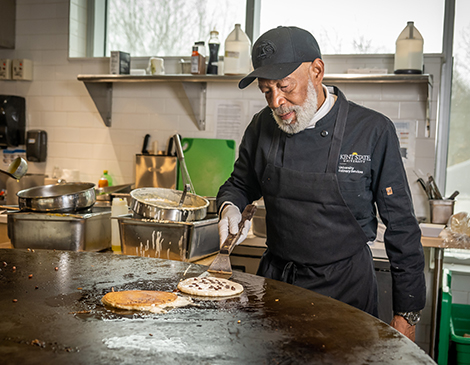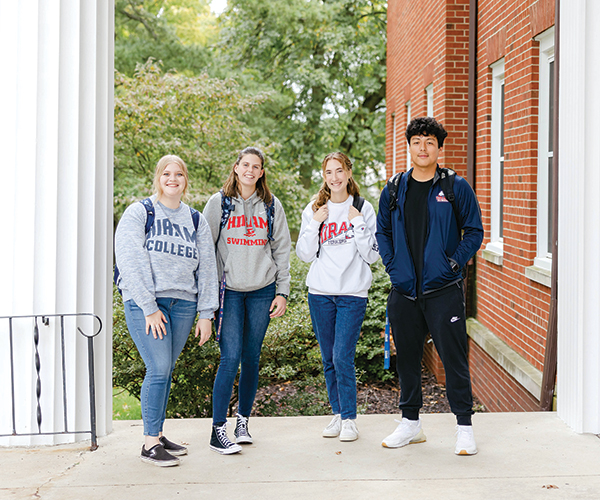Scrolling through the morning’s TxtandTell dining messages, Hannah Keil intercepts a bunch of remarks related to the Joy Cookie. “One student said, ‘Please tell the person who gave you the recipe, ‘I love those!’”
During Black History Month, Kent State University invited students to submit family recipes for main campus venues to serve. This is one of many asks. The dining program is always asking because students, now more than ever, are part of the discussion as to what is made available to eat.
Keil is a junior and marketing intern for Housing and Culinary Services. She’s the TxtandTell point person. She hears the raves and grumbles — mostly ideas — from students. She understands behind-the-scenes logistics like managing “where’s the hot sauce” inquiries. This is a highly active communications role.

Case in point: the condiment question introduced a campaign of TxtandTells.
“There was a band of students who wanted the hot sauce at one of our locations, and after getting multiple messages every single day, we sourced it and made sure it was available,” Keil says.
Success.
“Students completely drive our dining program,” says Sarah Korzan, registered dietitian and assistant director for Kent State University Culinary Services.
Uh, oh. The broccoli is overcooked.
“A student standing in a dining hall line can TxtandTell us that and I can in real-time reply, ‘Which station?’ and then tell my chef in the unit,” Korzan says.
Students even got to help name the campus-branded pizza place, Home Slice.
“Food is such a personal expression of your culture, identity and family,” Korzan says, proud to deliver a dining program that offers a “norm” in an otherwise hectic university life. “We have to make sure everyone feels like they have that sense of belonging and home.”
Voice at the Table
Aside from TxtandTell, Kent State’s dining service group holds focus groups, collects surveys and attends student inter-
hall council meetings to gather opinions. A vendor event on campus last year — a dining vendor show — attracted more than 600 students for tastings and feedback.
Three years ago, the university departed from a third-party contractor and transitioned to a self-operated program that, Korzan says, “is responsive to students.”
All in all, dining at school looks a whole lot different than students’ parents and even older siblings remember.
“Gone are the days of food trays, menus where every Thursday is meatloaf, and even the word ‘cafeteria,’” says Heather Piper, who attended the University of Akron and has worked in dining services there for the last 20 years. She is now employed by its hospitality provider, Aramark. “Students are focused on experience rather than the simple transition of going through a dining hall line.”
That experience at the University of Akron includes Starship robots for mobile meal delivery and an online ordering platform, along with self-service kiosks. With 17 dining locations across campus and partnerships with brands like Starbucks, Chik-fil-A, Einstein Brothers Bagels, Panda Express and Qdoba, Akron’s program variety and format have evolved drastically in recent years.
Appealing to Many Palates
Baldwin Wallace University’s independent dining department develops and executes recipes, managing every aspect of eating while earning credit hours. An evolving five-week menu includes a half-dozen stations in main dining halls, from pho bowls to grilled items.
The salad bar rules.
“But some students have asked for changes, so we keep it up to date,” says Marie Oravec, campus dietitian. “Recently, we added an area dedicated to yogurts and toppings so they can make a healthy parfait, and it’s something they can create and control the portion and nutrients.”
A hummus bar is designed with the same intentions. Various flavors of the chickpea-based protein mingle with couscous salads, pita bread, and carrots and celery as “scooping items other than chips,” Oravec relates.
A smoothie bar inside the campus recreation center is comparable to the franchise Pulp, she adds. Stingers Market is a convenient store emulating Sheetz. Colony Café is a la Panera with salads, soups and wraps. A fully licensed Starbucks on campus where students can use meal swipes is always busy. “We also partner with Boss ChickNBeer and Domino’s,” says Charles Fairchild, senior director of auxiliary services at Baldwin Wallace.
“We’re smoking our own meats — we’ll even smoke cauliflower and broccoli for Pho bowls,” Fairchild relates.
Yet, many students still love those homestyle staples.
Kent State’s “comfort station” offers meatloaf, mashed potatoes, green beans, corn and more eclectic feel-good foods like the Indian dish butter chicken, or Moroccan rice. Jambalaya wins second helpings, and breakfast-for-dinner delivers a diner vibe without the late-night hours.
The ‘Top Nine’ and Diverse Dining
College dining now pays close attention to food allergens, dietary preferences and restrictions, international foods and eating for high performance. At BW, a dedicated walk-in dining hall space minus the top nine food allergens offers segmented dining. It’s a win with not just those who manage allergies, Fairchild says. “The athletes love it, many students love it because it’s clean,” he relates.
BW will prepare individual meals for students with celiac disease and allergies, Fairchild says. “Our team and chefs get to know them.”
Oravec meets with families and students “all the time” and conducts allergy training with employees. BW also partnered with Michael Suhy of Allison Rose Foundation as the first university to stock epinephrine pens in dining halls.
Kent State offers the first certified free-from peanuts, treenuts and coconut dining facility.
Piper says this year’s new online menu tool via the dining services website at Akron calls out allergens. “At our stations, we have ingredient cards that list any allergens,” she says. “We also have a health and wellness roadmap for those who follow a gluten-friendly, vegan or vegetarian diet.”
Overall, with ever-expanding choices, tech-enabled conveniences, national brands and grab-and-go selections, the universities we spoke to collectively agreed that dining on campus is on the incline. Anecdotally, Piper cites an increase in commuter meal plan purchases. Faculty are also taking advantage of healthy options.
“It’s definitely important for colleges to have a healthy variety of options and diverse portfolio,” Piper says. “But Ramen will always be associated with college living.”
For more updates about Cleveland, sign up for our Cleveland Magazine Daily newsletter, delivered to your inbox six times a week.
Cleveland Magazine is also available in print, publishing 12 times a year with immersive features, helpful guides and beautiful photography and design.




